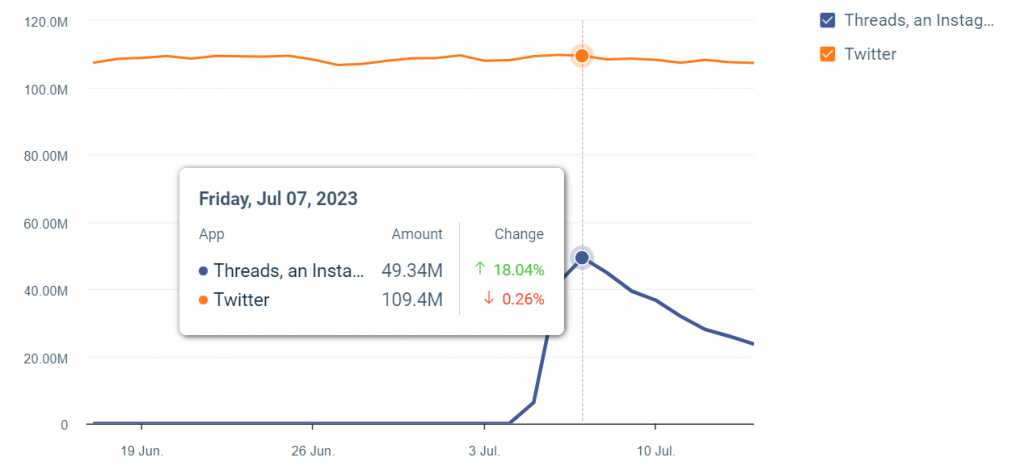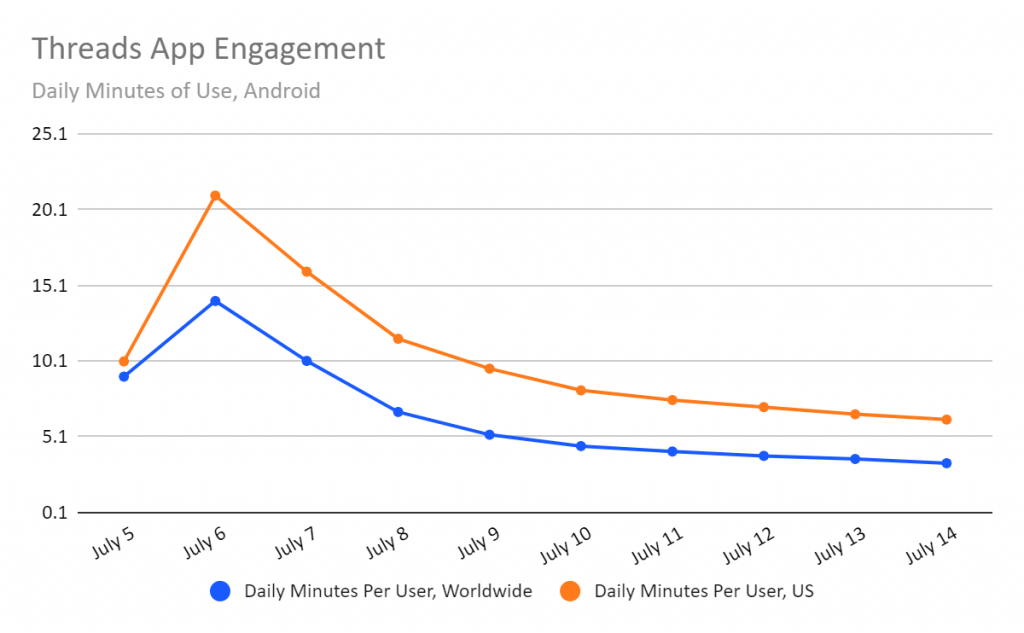With the rise of online communities and social media platforms, the usage of threads has become a popular way for users to engage in discussions, share information, and connect with like-minded individuals. However, recent data indicates that threads usage has experienced a significant drop, declining by half from its initial surge. In this blog, we delve into the reasons behind this shift in user behavior, explore potential contributing factors, and discuss the implications for online communities and platforms.
Despite a promising start, Threads’ daily active users fell from 49 million to 23.6 million in a week, making it a candidate among potential Twitter substitutes. Threads is off to a solid start in the battle to unseat Twitter, but it still has a ways to go to gain the steadfast commitment of users who prefer a social network where the majority of messages are texts and links to articles. The Threads spin-off from Meta’s Instagram business branch does not yet have regular users despite drawing significantly more attention than Twitter competitors like the open-source Mastodon or the still-beta Bluesky.
User drop-offs, often referred to as “thread abandonment,” occur when users leave a discussion, conversation, or thread without contributing or interacting further. This behavior can manifest in various forms, such as failing to reply to a post, not clicking on provided links, or simply exiting the conversation midway. The study of user drop-offs is essential in improving community engagement and retention.
Users are more likely to drop off when they encounter content that doesn’t resonate with them or fails to capture their interest. Inconsistent or unclear topics can deter users from participating in the conversation.
Negative interactions, hostile behavior, or the lack of moderation can create an unwelcoming environment, prompting users to leave the thread to avoid confrontation.
Excessively long threads can overwhelm users, making it challenging to find relevant information or engage effectively. Dense blocks of text may discourage users from reading and participating.
Threads with delayed responses can lead to user impatience, causing them to drop off and seek more immediate interactions elsewhere.
With the increasing use of mobile devices, threads that are not optimized for mobile can frustrate users, leading to higher drop-off rates.
Ensure that thread topics are relevant to the community’s interests. Encourage a diverse range of content to attract a wider audience and keep discussions fresh.
Promote a respectful and inclusive community culture. Implement clear moderation guidelines to address toxic behavior promptly.
When threads become extensive, consider breaking them into more manageable sub-topics or create new threads to maintain user engagement.
Efficiently respond to user queries and encourage other community members to participate actively in the discussions.
Ensure that the platform and threads are optimized for mobile devices to enhance user experience and reduce drop-offs.
By enabling Instagram users to immediately create a Threads account and import their current contacts, Threads, to a large extent, overcomes the “empty party problem” that makes it difficult to launch a new online community. Our daily usage figures support Meta’s assertion that it has generated more than 100 million total account signups in a matter of days. Though Threads lacks a number of fundamental capabilities, it still needs to provide users with compelling reasons to move from Twitter or establish a new social media habit with Threads.
In a short period of time, Threads captured a significant part of Twitter’s market
Here’s a quick comparison of how the two fared in the days following the initial enthusiasm.

An overall decline in daily minutes of use has been observed
The most popular app in the US was Threads,Because it’s unavailable in the EU, another important market, Threads attracted the most usage within the US. On July 7, US users averaged 21 minutes of active time on the app, which demonstrates how eager they were to explore Threads and see who else was there. On July 14, though, that time had decreased to just over 6 minutes.

There are various indications that Twitter’s market share may be directly impacted by Threads threads. The first two full days that Threads was broadly available, Thursday and Friday, saw a 5% decrease in web traffic to Twitter.com compared to those same days the week before, and a 4.3% decrease in time spent using the Twitter Android app.
Twitter’s declining user retention is a terrible indication for app user adherence. After 30 days, fewer new Android users are still frequently using the Twitter app, with the percentage falling from 19% in May 2022 to 16% in May 2023. The loyalty of new Instagram users, in comparison, has remained constant at around 40%.
Understanding user drop-offs in online threads is essential for building a thriving and engaged online community. By addressing the factors contributing to drop-offs and implementing effective strategies to retain users, content creators and community moderators can foster a positive environment that encourages active participation and enriches the overall user experience. A comprehensive approach to user engagement will contribute significantly to the long-term success of online platforms and communities.
Arushi is a proficient SEO and ASO specialist with a 5-year track record working for B2B and B2C organizations. Currently, she is heading SEO strategy for Vaizle and helping businesses improve their online presence. A mountain girl at heart, she likes to recharge her creative abilities by taking long walks and listening to podcasts.